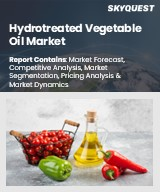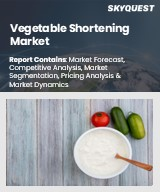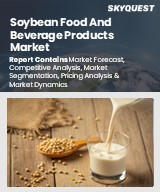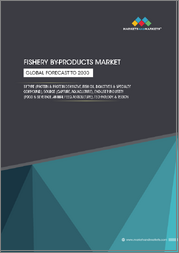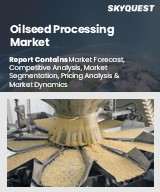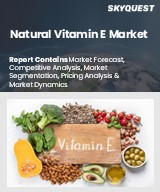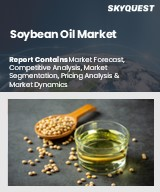
|
시장보고서
상품코드
1617080
대두 시장 예측(-2030년) : 제품 유형, 공급원, 유통 채널, 형태, 용도, 지역별 세계 분석Soybean Market Forecasts to 2030 - Global Analysis By Product Type (Soybean Seeds, Soybean Oil, Soy Meal, Soy Protein, Soy Lecithin and Other Product Types), Source, Distribution Channel, Form, Application and By Geography |
||||||
Stratistics MRC에 따르면 세계의 대두 시장은 2024년에 1,664억 달러를 차지하며 예측 기간 중 CAGR 6.6%로 성장하며, 2030년에는 2,441억 7,000만 달러에 달할 전망입니다. 콩은 단백질, 오일 및 기타 필수 영양소가 풍부한 종자를 얻기 위해 널리 재배되는 동아시아 원산의 콩과 식물입니다. 다용도로 알려진 콩은 두부, 두유, 간장 등 다양한 식품과 가축 사료에 사용됩니다. 콩오일은 요리와 산업용으로 사용되는 주요 식물성 오일입니다. 또한 식물성 단백질의 주요 공급원이기 때문에 채식주의자나 채식주의자의 식단에 자주 사용되며, 바이오연료 생산에도 필수적입니다.
미국 농무부에 따르면 미국의 대두유 생산량은 2019년 1,130만 톤에서 2023년 1,228만 톤에 달할 것으로 예상됩니다. 이러한 대두유 수요 증가는 예측 기간 중 시장을 강화할 것으로 보입니다.
식물성 단백질에 대한 수요 증가
식물성 단백질의 인기가 높아지면서 대두 시장의 성장을 가속하는 주요 요인으로 작용하고 있습니다. 점점 더 많은 소비자들이 채식주의자, 비건, 플렉시테리언으로 식습관을 바꾸면서 고품질 단백질이 풍부한 콩은 식물성 식품의 중요한 원료가 되고 있습니다. 콩 단백질은 대체 육류, 대체 유제품, 단백질이 풍부한 스낵 등 다양한 제품에 사용되어 건강을 중시하는 소비자와 지속가능한 식품을 찾는 소비자들에게 어필하고 있습니다. 식물성 식단의 환경적 이점에 대한 인식이 높아짐에 따라 대두 기반 제품에 대한 수요가 더욱 증가하고 있으며, 전 세계 식품 산업에서 대두는 중요한 단백질 공급원으로 자리매김하고 있습니다.
대두 과다 섭취로 인한 건강 우려
대두 과다 섭취로 인한 잠재적 건강 위험에 대한 우려가 대두 시장에 영향을 미치고 있습니다. 일부 연구에 따르면 콩 제품, 특히 식물성 에스트로겐이 함유된 콩 제품의 과다 섭취는 호르몬 균형을 깨뜨려 갑상선 기능 장애, 생식 건강 문제 등을 유발할 수 있다고 합니다. 또한 과다 섭취는 콩 알레르기가 있는 사람에게 위험을 초래할 수 있습니다. 이러한 우려로 인해 소비자들은 신중하게 행동하게 되었고, 일부 사람들은 콩 제품을 피하고 다른 식물성 단백질 공급원을 선호하게 되었습니다. 콩을 적당히 섭취하는 것이 건강에 유익함에도 불구하고 이러한 건강 관련 우려 증가는 특히 특정 시장과 계층에서 콩 제품에 대한 수요에 영향을 미칠 수 있습니다.
콩 재배의 기술 혁신
대두 재배의 기술 혁신은 대두 시장 확대에 크게 기여하고 있습니다. 유전자 변형(GM) 종자, 정밀농업, 첨단 관개 기술 등의 혁신은 작물 수확량을 향상시키고 콩 생산을 보다 효율적이고 탄력적으로 만들고 있습니다. 예를 들어 유전자 변형 콩은 병해충과 환경적 스트레스에 대한 내성을 갖도록 설계되어 농약의 필요성이 줄어들어 전반적인 생산성이 향상됩니다. 또한 센서 및 위성 이미지와 같은 데이터베이스 기술을 통해 농가는 작물 재배, 관개 및 수확 과정을 최적화할 수 있으며, 생산 효율성이 더욱 향상되어 전 세계 대두 수요 증가에 대응할 수 있게 됩니다.
기후 변화와 날씨 리스크
기후 변화와 날씨 관련 리스크는 대두 시장에 큰 장애물이 되고 있습니다. 콩은 날씨에 매우 민감하며, 가뭄, 홍수, 예기치 못한 기온 변화와 같은 극단적인 사건은 작물 수확량에 심각한 영향을 미칠 수 있습니다. 미국 중서부나 브라질과 같은 주요 산지에서는 강우 패턴의 변화나 장기간의 건기는 수확량 감소와 생산비 상승으로 이어질 수 있습니다. 이러한 예측할 수 없는 기상 현상은 공급망을 혼란에 빠뜨릴 뿐만 아니라 시장에 가격 변동을 가져와 생산자의 계획을 어렵게 하고, 세계 대두 공급 능력에 영향을 미쳐 식량 생산과 세계 무역에 영향을 미칠 수 있습니다.
COVID-19의 영향
COVID-19 팬데믹은 콩 시장에 다양한 영향을 미쳤습니다. 처음에는 노동력 부족, 운송 지연 등 세계 공급망의 혼란으로 인해 대두 생산과 유통에 어려움을 겪었습니다. 그러나 팬데믹으로 인해 소비자들은 더 건강한 식품을 찾게 되었고, 식물성 단백질에 대한 수요도 증가하였습니다. 식물성 식단 증가는 콩 제품, 특히 대체 육류에 대한 수요를 증가시켰습니다. 또한 가축 사료 생산이 중단되면서 대두박에 대한 의존도가 높아져 대두 수요가 더욱 높아졌습니다.
대두박 분야는 예측 기간 중 최대 규모에 달할 것으로 예상됩니다.
대두박 부문은 특히 양계, 양돈, 목축업에서 고단백 동물 사료로 사용되면서 가장 큰 규모를 형성할 것으로 예상됩니다. 육류 및 유제품에 대한 세계 수요가 증가함에 따라 효율적이고 영양가 높은 동물 사료에 대한 수요도 증가하고 있습니다. 또한 환경과 건강에 대한 우려로 인해 보다 지속가능한 식물성 사료로의 전환이 대두박의 인기를 더욱 높이고 있습니다. 비용 효율적이고 영양가가 높은 대두박은 전 세계에서 가축 사료로 선호되고 있습니다.
예측 기간 중 가장 높은 CAGR을 보일 것으로 예상되는 분야는 동물 사료 분야입니다.
대두 가공 제품별로는 대두박은 가축에게 중요한 단백질 공급원이기 때문에 동물 사료 분야가 예측 기간 중 가장 높은 CAGR을 나타낼 것으로 예상됩니다. 전 세계에서 육류 및 유제품 소비가 증가함에 따라 특히 신흥 경제국에서 고품질의 비용 효율적인 동물 사료에 대한 수요가 증가하고 있습니다. 콩은 고단백질, 소화율이 높고 영양가가 높아 사료 원료로 선호되고 있습니다. 또한 지속가능한 식물성 동물 사료에 대한 수요가 증가함에 따라 동물 영양학에서 대두의 활용이 더욱 촉진되고 있습니다.
가장 큰 점유율을 차지하는 지역 :
아시아태평양은 건강 지향 증가와 식물성 식단의 인기로 인해 두부, 두유, 콩 단백질과 같은 콩 기반 제품에 대한 수요가 증가함에 따라 예측 기간 중 가장 큰 시장 점유율을 차지할 것으로 예상됩니다. 또한 이 지역의 축산 부문이 확대되고 있으며, 주요 사료 원료로 대두박에 대한 수요가 증가하고 있습니다. 도시화의 진전, 소득 증가, 식습관 변화로 인해 대두 제품에 대한 수요가 더욱 증가하고 있습니다. 또한 중국 및 인도와 같은 국가에서 바이오연료 생산이 확대되고 있는 것도 이 지역의 대두 시장 성장을 지원하고 있습니다.
CAGR이 가장 높은 지역 :
북미는 식품, 사료, 바이오연료 부문에서 대두 기반 제품에 대한 수요가 증가하면서 예측 기간 중 가장 높은 CAGR을 나타낼 것으로 예상됩니다. 미국은 대두의 주요 생산국이자 수출국이며, 식물성 식품 및 육류 대체품으로 대두 단백질의 소비가 증가하고 있습니다. 축산 산업의 성장은 사료용 대두박에 대한 수요를 더욱 증가시킬 것입니다. 또한 정부 정책과 지속가능성 목표에 힘입어 바이오디젤 생산이 증가하면서 북미 대두 시장의 지속적인 성장에 기여하고 있습니다.
무료 커스터마이징 서비스
이 보고서를 구독하는 고객은 다음과 같은 무료 맞춤화 옵션 중 하나를 사용할 수 있습니다. :
- 기업 개요
- 추가 시장 기업 종합 프로파일링(최대 3사)
- 주요 기업의 SWOT 분석(최대 3사)
- 지역 세분화
- 고객의 관심에 따른 주요 국가별 시장 추정치, 예측, CAGR(주: 타당성 확인에 따라 다름)
- 경쟁사 벤치마킹
- 제품 포트폴리오, 지역적 입지, 전략적 제휴를 기반으로 한 주요 기업 벤치마킹
목차
제1장 개요
제2장 서문
- 개요
- 이해관계자
- 조사 범위
- 조사 방법
- 데이터 마이닝
- 데이터 분석
- 데이터 검증
- 조사 어프로치
- 조사 정보원
- 1차 조사 정보원
- 2차 조사 정보원
- 전제조건
제3장 시장 동향 분석
- 촉진요인
- 억제요인
- 기회
- 위협
- 제품 분석
- 용도 분석
- 신흥 시장
- COVID-19의 영향
제4장 Porter's Five Forces 분석
- 공급 기업의 교섭력
- 바이어의 교섭력
- 대체품의 위협
- 신규 진출업체의 위협
- 경쟁 기업 간 경쟁 관계
제5장 세계의 대두 시장 : 제품 유형별
- 대두 종자
- 대두유
- 대두 밀
- 대두 단백질
- 대두 레시틴
- 기타 제품 유형
제6장 세계의 대두 시장 : 공급원별
- 기존형
- 유전자재조합 생물(GMO)
- 비유전자재조합 생물(비GMO)
- 오가닉
제7장 세계의 대두 시장 : 유통 채널별
- 직접 판매
- 간접 판매
제8장 세계의 대두 시장 : 형태별
- 가공
- 생
제9장 세계의 대두 시장 : 용도별
- 식품 및 음료
- 동물 사료
- 바이오디젤
- 의약품
- 퍼스널케어와 화장품
- 식이보충제
- 기타 용도
제10장 세계의 대두 시장 : 지역별
- 북미
- 미국
- 캐나다
- 멕시코
- 유럽
- 독일
- 영국
- 이탈리아
- 프랑스
- 스페인
- 기타 유럽
- 아시아태평양
- 일본
- 중국
- 인도
- 호주
- 뉴질랜드
- 한국
- 기타 아시아태평양
- 남미
- 아르헨티나
- 브라질
- 칠레
- 기타 남미
- 중동 및 아프리카
- 사우디아라비아
- 아랍에미리트
- 카타르
- 남아프리카공화국
- 기타 중동 및 아프리카
제11장 주요 발전
- 계약, 파트너십, 협업, 합병사업
- 인수와 합병
- 신제품 발매
- 사업 확대
- 기타 주요 전략
제12장 기업 프로파일링
- Cargill, Inc.
- Archer Daniels Midland Company(ADM)
- Bunge Limited
- Louis Dreyfus Company(LDC)
- Olam Group
- China National Chemical Corporation
- Wilmar International Limited
- Sojaprotein
- Golden State Foods Corporation
- COFCO Corporation
- Sime Darby Plantation
- Sinograin
- Tate & Lyle PLC
- Tyson Foods, Inc.
- Ruchi Soya Industries Ltd.
- Adani Wilmar Limited
- The Scoular Company
- The Andersons, Inc.
- Bunge Brazil
- Viterra Inc.
According to Stratistics MRC, the Global Soybean Market is accounted for $166.40 billion in 2024 and is expected to reach $244.17 billion by 2030 growing at a CAGR of 6.6% during the forecast period. Soybean is a leguminous plant native to East Asia, widely cultivated for its seeds, which are rich in protein, oil, and other essential nutrients. Known for its versatility, soybeans are used in a variety of food products, including tofu, soy milk, and soy sauce, as well as animal feed. Soybean oil is a major vegetable oil used in cooking and industrial applications. The plant is also a key source of plant-based protein, making it a popular ingredient in vegan and vegetarian diets, and is crucial for biofuel production.
According to the USDA, U.S. soybean oil production reached 12.28 million metric tons in 2023, up from 11.3 million metric tons in 2019. This growing demand for soybean oil is set to bolster the market during the forecast period.
Market Dynamics:
Driver:
Increasing demand for plant-based proteins
The rising popularity of plant-based proteins is a key factor driving growth in the soybean market. As more consumers shift toward vegetarian, vegan, and flexitarian diets, soybeans, which are rich in high-quality protein, have become a key ingredient in plant-based food products. Soy protein is used in a wide range of meat alternatives, dairy substitutes, and protein-rich snacks, appealing to health-conscious consumers and those seeking sustainable food options. The growing awareness of the environmental benefits of plant-based diets further boosts the demand for soy-based products, positioning soybeans as a critical source of protein in the global food industry.
Restraint:
Health concerns over excessive soy consumption
Concerns about the potential health risks of consuming too much soy are affecting the soybean market. Some studies suggest that high intake of soy products, particularly those containing phytoestrogens, may disrupt hormonal balance, potentially leading to issues like thyroid dysfunction or reproductive health concerns. Additionally, excessive consumption may pose risks for individuals with soy allergies. These concerns have led to cautious consumer behavior, with some avoiding soy-based products in favour of other plant-based protein sources. Despite the health benefits of moderate soy consumption, these growing health-related worries may influence the demand for soy products, particularly in certain markets and demographics.
Opportunity:
Technological advancements in soybean farming
Technological innovations in soybean farming are significantly contributing to the expansion of the soybean market. Innovations such as genetically modified (GM) seeds, precision farming, and advanced irrigation techniques have enhanced crop yields, making soybean production more efficient and resilient. GM soybeans, for example, are designed to be resistant to pests, diseases, and environmental stress, which reduces the need for pesticides and increases overall productivity. Additionally, data-driven technologies, like sensors and satellite imagery, enable farmers to optimize planting, irrigation, and harvesting processes, further boosting production efficiency and meeting the rising global demand for soybeans.
Threat:
Climate change and weather risks
Climate change and weather-related risks present major obstacles to the soybean market. Soybeans are highly sensitive to weather conditions, and extreme events such as droughts, floods, or unexpected temperature shifts can severely impact crop yields. Shifting rainfall patterns and prolonged dry spells in key growing regions, like the U.S. Midwest and Brazil, can lead to reduced harvests and increased production costs. These unpredictable weather events not only disrupt supply chains but also create price volatility in the market, making it harder for producers to plan and affecting global soybean availability, which in turn influences food production and global trade.
Covid-19 Impact
The COVID-19 pandemic had a mixed impact on the soybean market. Initially, the global supply chain disruptions, including labor shortages and transportation delays, led to challenges in soybean production and distribution. However, the pandemic also led to an increased demand for plant-based proteins as consumers turned to healthier food options. The rise in plant-based diets boosted the demand for soy products, especially in meat alternatives. Additionally, disruptions in animal feed production led to a greater reliance on soymeal, further driving soybean demand.
The soy meal segment is expected to be the largest during the forecast period
The soy meal segment is estimated to be the largest, due to its use as a high-protein animal feed, especially in poultry, swine, and cattle farming. As the global demand for meat and dairy products increases, the need for efficient and nutritious animal feed also rises. Additionally, the shift toward more sustainable and plant-based feed options, due to environmental and health concerns, further boosts the popularity of soy meal. Its cost-effectiveness and high nutritional value make it a preferred choice for livestock feed globally.
The animal feed segment is expected to have the highest CAGR during the forecast period
The animal feed segment is anticipated to witness the highest CAGR during the forecast period, as soy meal, a by-product of soybean processing, is a vital protein source for livestock. As global meat and dairy consumption increases, especially in emerging economies, the need for high-quality, cost-effective animal feed rises. Soybeans are a preferred feed ingredient due to their high protein content, digestibility, and nutritional benefits. Additionally, the growing trend of sustainable and plant-based animal feed options further drives soybean usage in animal nutrition.
Region with largest share:
Asia Pacific is expected to have the largest market share during the forecast period due to increasing demand for soy-based products, such as tofu, soy milk, and soy protein, due to rising health consciousness and the popularity of plant-based diets. Additionally, the region's growing livestock sector fuels demand for soy meal as a key animal feed ingredient. Increasing urbanization, rising incomes, and changing dietary patterns further contribute to the demand for soy products. Additionally, the expansion of biofuel production in countries like China and India also supports soybean market growth in the region.
Region with highest CAGR:
North America is projected to witness the highest CAGR over the forecast period, owing to strong demand for soy-based products in food, animal feed, and biofuel sectors. The U.S. is a major producer and exporter of soybeans, with increasing consumption of soy protein in plant-based food products and meat substitutes. The growing livestock industry further boosts the demand for soy meal in animal feed. Additionally, the rise in biodiesel production, supported by government policies and sustainability goals, contributes to the continued growth of the soybean market in North America.
Key players in the market
Some of the key players profiled in the Soybean Market include Cargill, Inc., Archer Daniels Midland Company (ADM), Bunge Limited, Louis Dreyfus Company (LDC), Olam Group, China National Chemical Corporation, Wilmar International Limited, Sojaprotein, Golden State Foods Corporation, COFCO Corporation, Sime Darby Plantation, Sinograin, Tate & Lyle PLC, Tyson Foods, Inc., Ruchi Soya Industries Ltd., Adani Wilmar Limited, The Scoular Company, The Andersons, Inc., Bunge Brazil, and Viterra Inc.
Key Developments:
In November 2023, Cargill launched a new line of plant-based soy protein products designed for the food industry, aimed at meeting the growing demand for plant-based proteins in meat alternatives and other food products.
In August 2023, Bunge introduced a new soybean oil refining process that increases efficiency and reduces energy consumption, improving sustainability in the production of soybean oil for food and industrial applications.
In May 2023, Archer Daniels Midland (ADM) announced the expansion of its plant-based protein portfolio, including new formulations of soy protein isolates and concentrates to cater to the growing demand for vegan and plant-based foods.
In March 2023, Olam introduced new soy protein concentrates aimed at the food and beverage industry, specifically designed to enhance texture and protein content in meat analogs and snacks.
Product Types Covered:
- Soybean Seeds
- Soybean Oil
- Soy Meal
- Soy Protein
- Soy Lecithin
- Other Product Types
Sources Covered:
- Conventional
- Organic
Distribution Channels Covered:
- Direct Sales
- Indirect Sales
Forms Covered:
- Processed
- Raw
Applications Covered:
- Food and Beverages
- Animal Feed
- Biodiesel
- Pharmaceuticals
- Personal Care and Cosmetics
- Dietary Supplements
- Other Applications
Regions Covered:
- North America
- US
- Canada
- Mexico
- Europe
- Germany
- UK
- Italy
- France
- Spain
- Rest of Europe
- Asia Pacific
- Japan
- China
- India
- Australia
- New Zealand
- South Korea
- Rest of Asia Pacific
- South America
- Argentina
- Brazil
- Chile
- Rest of South America
- Middle East & Africa
- Saudi Arabia
- UAE
- Qatar
- South Africa
- Rest of Middle East & Africa
What our report offers:
- Market share assessments for the regional and country-level segments
- Strategic recommendations for the new entrants
- Covers Market data for the years 2022, 2023, 2024, 2026, and 2030
- Market Trends (Drivers, Constraints, Opportunities, Threats, Challenges, Investment Opportunities, and recommendations)
- Strategic recommendations in key business segments based on the market estimations
- Competitive landscaping mapping the key common trends
- Company profiling with detailed strategies, financials, and recent developments
- Supply chain trends mapping the latest technological advancements
Free Customization Offerings:
All the customers of this report will be entitled to receive one of the following free customization options:
- Company Profiling
- Comprehensive profiling of additional market players (up to 3)
- SWOT Analysis of key players (up to 3)
- Regional Segmentation
- Market estimations, Forecasts and CAGR of any prominent country as per the client's interest (Note: Depends on feasibility check)
- Competitive Benchmarking
- Benchmarking of key players based on product portfolio, geographical presence, and strategic alliances
Table of Contents
1 Executive Summary
2 Preface
- 2.1 Abstract
- 2.2 Stake Holders
- 2.3 Research Scope
- 2.4 Research Methodology
- 2.4.1 Data Mining
- 2.4.2 Data Analysis
- 2.4.3 Data Validation
- 2.4.4 Research Approach
- 2.5 Research Sources
- 2.5.1 Primary Research Sources
- 2.5.2 Secondary Research Sources
- 2.5.3 Assumptions
3 Market Trend Analysis
- 3.1 Introduction
- 3.2 Drivers
- 3.3 Restraints
- 3.4 Opportunities
- 3.5 Threats
- 3.6 Product Analysis
- 3.7 Application Analysis
- 3.8 Emerging Markets
- 3.9 Impact of Covid-19
4 Porters Five Force Analysis
- 4.1 Bargaining power of suppliers
- 4.2 Bargaining power of buyers
- 4.3 Threat of substitutes
- 4.4 Threat of new entrants
- 4.5 Competitive rivalry
5 Global Soybean Market, By Product Type
- 5.1 Introduction
- 5.2 Soybean Seeds
- 5.3 Soybean Oil
- 5.4 Soy Meal
- 5.5 Soy Protein
- 5.6 Soy Lecithin
- 5.7 Other Product Types
6 Global Soybean Market, By Source
- 6.1 Introduction
- 6.2 Conventional
- 6.2.1 Genetically Modified Organisms (GMO)
- 6.2.2 Non-genetically Modified Organism (Non-GMO)
- 6.3 Organic
7 Global Soybean Market, By Distribution Channel
- 7.1 Introduction
- 7.2 Direct Sales
- 7.3 Indirect Sales
8 Global Soybean Market, By Form
- 8.1 Introduction
- 8.2 Processed
- 8.3 Raw
9 Global Soybean Market, By Application
- 9.1 Introduction
- 9.2 Food and Beverages
- 9.3 Animal Feed
- 9.4 Biodiesel
- 9.5 Pharmaceuticals
- 9.6 Personal Care and Cosmetics
- 9.7 Dietary Supplements
- 9.8 Other Applications
10 Global Soybean Market, By Geography
- 10.1 Introduction
- 10.2 North America
- 10.2.1 US
- 10.2.2 Canada
- 10.2.3 Mexico
- 10.3 Europe
- 10.3.1 Germany
- 10.3.2 UK
- 10.3.3 Italy
- 10.3.4 France
- 10.3.5 Spain
- 10.3.6 Rest of Europe
- 10.4 Asia Pacific
- 10.4.1 Japan
- 10.4.2 China
- 10.4.3 India
- 10.4.4 Australia
- 10.4.5 New Zealand
- 10.4.6 South Korea
- 10.4.7 Rest of Asia Pacific
- 10.5 South America
- 10.5.1 Argentina
- 10.5.2 Brazil
- 10.5.3 Chile
- 10.5.4 Rest of South America
- 10.6 Middle East & Africa
- 10.6.1 Saudi Arabia
- 10.6.2 UAE
- 10.6.3 Qatar
- 10.6.4 South Africa
- 10.6.5 Rest of Middle East & Africa
11 Key Developments
- 11.1 Agreements, Partnerships, Collaborations and Joint Ventures
- 11.2 Acquisitions & Mergers
- 11.3 New Product Launch
- 11.4 Expansions
- 11.5 Other Key Strategies
12 Company Profiling
- 12.1 Cargill, Inc.
- 12.2 Archer Daniels Midland Company (ADM)
- 12.3 Bunge Limited
- 12.4 Louis Dreyfus Company (LDC)
- 12.5 Olam Group
- 12.6 China National Chemical Corporation
- 12.7 Wilmar International Limited
- 12.8 Sojaprotein
- 12.9 Golden State Foods Corporation
- 12.10 COFCO Corporation
- 12.11 Sime Darby Plantation
- 12.12 Sinograin
- 12.13 Tate & Lyle PLC
- 12.14 Tyson Foods, Inc.
- 12.15 Ruchi Soya Industries Ltd.
- 12.16 Adani Wilmar Limited
- 12.17 The Scoular Company
- 12.18 The Andersons, Inc.
- 12.19 Bunge Brazil
- 12.20 Viterra Inc.






